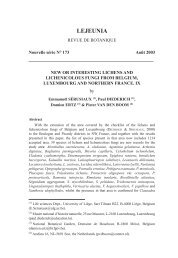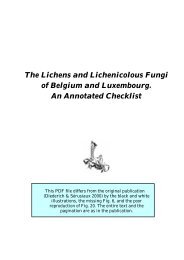A Synopsis of the Genera Skyttea, Llimoniella and - Lichens of ...
A Synopsis of the Genera Skyttea, Llimoniella and - Lichens of ...
A Synopsis of the Genera Skyttea, Llimoniella and - Lichens of ...
You also want an ePaper? Increase the reach of your titles
YUMPU automatically turns print PDFs into web optimized ePapers that Google loves.
466 THE LICHENOLOGIST Vol. 32<br />
Rhymbocarpus punctiformis Zopf, Hedwigia 35: 357 (1896); type: Italy, S. Tirol, St Ulrich in<br />
Groden, on Rhizocarpon geographicum, viii 1895, Arnold (M—holotypus, vid.); ibid., 10 viii 1898,<br />
Arnold Lichenes exs. 1772 (UPS—topotypus, vid.); ibid. ['Bolzano, Val Gardena (Grodner Tal),<br />
Ortisei (St Ulrich), 2-2-2 km NEE <strong>of</strong> centre, road 242 Ponte Gardena (Waidbruck)—Ortisei'], on<br />
R. geographicum, ix 1991, Triebel & Rambold 5968, 5969, 5973, 5974, 5975 (M—topotypi, vid.).<br />
(Fig. IB)<br />
For an illustration <strong>of</strong> <strong>the</strong> asci <strong>and</strong> ascospores, see Coppins et al. (1991).<br />
Ascomata aggregated in decolourized or bullate areoles <strong>of</strong> <strong>the</strong> host, at first<br />
immersed <strong>and</strong> ± peri<strong>the</strong>cioid, becoming apo<strong>the</strong>cioid when mature, normally<br />
remaining immersed, even when mature, rarely slightly erumpent, black;<br />
margin hardly visible, 50-120 (a.m diam. Exciple hyaline, except <strong>the</strong> upper part<br />
close to <strong>the</strong> epihymenium, which is greenish brown, composed <strong>of</strong> several rows<br />
<strong>of</strong> cells which are ± subglobose in <strong>the</strong> lower part <strong>and</strong> elongate in <strong>the</strong> upper<br />
part, 10-15 urn thick at <strong>the</strong> base <strong>and</strong> up to 30 \im above; excipular hairs absent<br />
or sparse, hyaline, tapered towards <strong>the</strong> apex, simple or with one septum.<br />
Subhymenium <strong>and</strong> hymenium hyaline. Epihymenium brownish to greenish.<br />
All parts KI — . Paraphyses simple to branched, hyaline, septate, slightly<br />
swollen at <strong>the</strong> apices. Asci elongate clavate, with a single functional wall<br />
layer, wall apically not thickened, I - <strong>and</strong> KI -, 8-spored. Ascospores<br />
ellipsoid, straight or slightly curved, simple, hyaline, smooth, with obtuse<br />
ends, 11-12 x 4-5 um.<br />
Hosts. Rhizocarpon atr<strong>of</strong>lavescens, R. geminatum <strong>and</strong> R. geographicum.<br />
Distribution. Greece, Italy <strong>and</strong> Sweden.<br />
Observations. The descriptions <strong>of</strong> R. geographici <strong>and</strong> R. punctiformis are<br />
extremely close. As both taxa have been collected on <strong>the</strong> same host species,<br />
<strong>the</strong>y most probably represent <strong>the</strong> same species. As <strong>the</strong> type <strong>of</strong> Nesolechia<br />
geographici is lost, we neotypify that name herewith on <strong>the</strong> type specimen <strong>of</strong><br />
Rhymbocarpus punctiformis to irrevocably fix <strong>the</strong> two names toge<strong>the</strong>r.<br />
Additional specimens examined. Sweden: Harjedalen, Tannas par., Mt Ashogen, sou<strong>the</strong>rn slope,<br />
950 m, on R. atr<strong>of</strong>lavescens, 1975, Santesson 26333 (UPS); Torne Lappmark, <strong>the</strong> Tornetrask<br />
Area, S <strong>of</strong> <strong>the</strong> railway station <strong>of</strong> Abisko, on R. geminatum, 1959, Santesson 13456a (UPS).<br />
Rhymbocarpus makarovae Diederich & Etayo sp. nov.<br />
Rhymbocarpus insignis ascomatibus immersis ad erumpentibus, atris, primo clausis, demum<br />
aperientibus, 100-200 urn, margine glabro, 3-4 pr<strong>of</strong>undis fissuris diviso ubi vetere, ascosporis<br />
ellipsoideis, aseptatis, 7-10 x 3-4 um.<br />
Typus: Russia, eastern coast <strong>of</strong> Chukchi Peninsula, Lavrentiya Bay, near Cape Krauze, on<br />
Porpidia sp., 10 July 1973, Makarova (LE—holotypus)<br />
(Fig. 13)<br />
Ascomata aggregated, immersed to erumpent, broadly attached to <strong>the</strong><br />
substratum, black, ± shiny, initially ± closed, 100-200 p.m diam.; margin,<br />
when old, divided by 3-4 deep cruciately arranged fissures, without excipular





